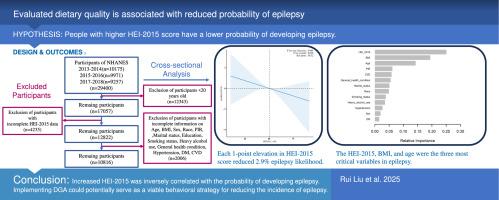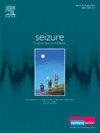Evaluated dietary quality is associated with reduced probability of epilepsy
IF 2.8
3区 医学
Q2 CLINICAL NEUROLOGY
引用次数: 0
Abstract
Background
The occurrence of epilepsy is significantly associated with the intake of specific nutrients such as calcium. However, the potential association between overall dietary quality and epilepsy remains undetermined.
Methods
Analytical data were retrieved from three consecutive cycles (2013–2018) of the National Health and Nutrition Examination Survey. Healthy Eating Index 2015 (HEI-2015) score was used to evaluate dietary quality. Univariate and multivariate logistic regression models were used to evaluate the association between HEI-2015 and epilepsy, while subgroup analyses were conducted to examine the interaction effects of epilepsy with various covariates. Additionally, linear regression model, generalized additive model, two-piecewise linear regression model, and extreme gradient boosting (XGBoost) algorithm model were applied to investigate the potential association between HEI-2015 and epilepsy.
Results
A 5.42-unit disparity was found in mean HEI-2015 scores between epilepsy (45.76±1.43) and non-epilepsy (51.18±0.31) groups. Multivariate models demonstrated a dose-response pattern, wherein each 1-point elevation in HEI-2015 score corresponded to a 2.9 % reduced probability of epilepsy (adjusted odds ratio (OR)=0.971, 95 % confidence interval (CI): 0.948–0.994, p = 0.015). Participants in the highest HEI-2015 quartile exhibited 73.9 % lower odds of epilepsy compared to those in the lowest quartile (p = 0.007). The generalized additive model, two-piecewise linear regression model, and subgroup analyses demonstrated a consistent and stable inverse relationship between HEI-2015 and epilepsy. The XGBoost model revealed that HEI-2015, body mass index, and age were the three most critical variables in epilepsy.
Conclusion
Increased HEI-2015 was inversely correlated with the probability of developing epilepsy. Implementing the Dietary Guidelines for Americans (DGA) could potentially serve as a viable behavioral strategy for reducing the incidence of epilepsy.

经评估的饮食质量与癫痫发生率降低有关
背景癫痫的发生与钙等特定营养素的摄入显著相关。然而,总体饮食质量与癫痫之间的潜在联系仍未确定。方法分析数据来源于2013-2018年连续三个周期的全国健康与营养检查调查。采用健康饮食指数2015 (HEI-2015)评分评价膳食质量。采用单因素和多因素logistic回归模型评价HEI-2015与癫痫的相关性,并通过亚组分析考察癫痫与各协变量的交互作用。此外,采用线性回归模型、广义加性模型、两分段线性回归模型和极限梯度增强(XGBoost)算法模型探讨HEI-2015与癫痫的潜在关联。结果癫痫组(45.76±1.43)与非癫痫组(51.18±0.31)的平均HEI-2015评分相差5.42个单位。多变量模型显示了剂量-反应模式,其中HEI-2015评分每升高1分,癫痫发生率降低2.9%(校正优势比(OR)=0.971, 95%可信区间(CI): 0.948-0.994, p = 0.015)。HEI-2015最高四分位数的参与者癫痫发病率比最低四分位数的参与者低73.9% (p = 0.007)。广义加性模型、两分段线性回归模型和亚组分析表明,HEI-2015与癫痫呈一致且稳定的负相关。XGBoost模型显示,HEI-2015、体重指数和年龄是癫痫的三个最关键变量。结论HEI-2015升高与癫痫发生概率呈负相关。实施美国人膳食指南(DGA)可能成为减少癫痫发病率的一种可行的行为策略。
本文章由计算机程序翻译,如有差异,请以英文原文为准。
求助全文
约1分钟内获得全文
求助全文
来源期刊

Seizure-European Journal of Epilepsy
医学-临床神经学
CiteScore
5.60
自引率
6.70%
发文量
231
审稿时长
34 days
期刊介绍:
Seizure - European Journal of Epilepsy is an international journal owned by Epilepsy Action (the largest member led epilepsy organisation in the UK). It provides a forum for papers on all topics related to epilepsy and seizure disorders.
 求助内容:
求助内容: 应助结果提醒方式:
应助结果提醒方式:


